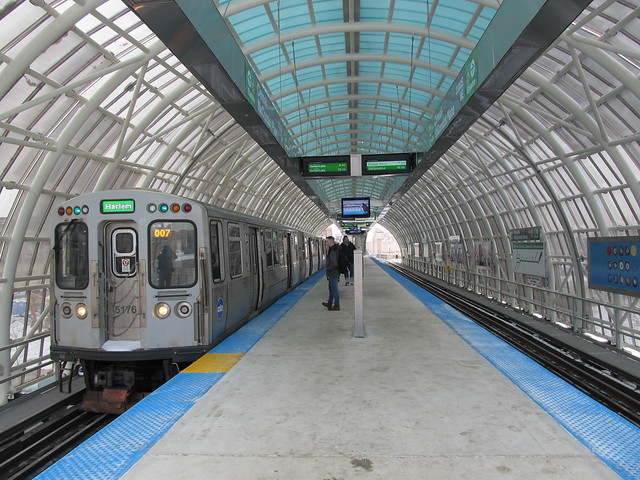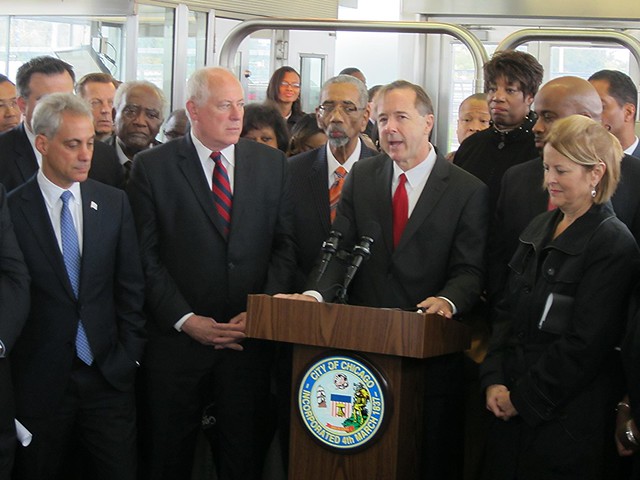Chicago Transit Authority President Forrest Claypool has worn many hats in local government. He twice served as Mayor Richard M. Daley’s chief of staff. He was superintendent of the Chicago Park District. And he’s been a Cook County commissioner. But, arguably, he’s made his biggest mark as head of the transit agency during the last four project-filled years.
Last Thursday, Mayor Rahm Emanuel announced that he’s pulling Claypool from the CTA to serve a third stint as the mayor’s chief of staff, replacing Lisa Schrader. It appears Emanuel feels Claypool, a longtime ally with records of balancing budgets at the park district and the transit agency, will be helpful for tackling the city’s $20 billion pension crisis. Emanuel cited Claypool’s successful overhaul of the South Red Line as a reason for his decision.
The mayor has not yet named the next CTA boss. Chicago Department of Transportation Commissioner Rebekah Scheinfeld, who previously served as director of planning for the transit agency, seems like a possibility. On the other hand, Claypool and the previous few CTA presidents have been expert managers, rather than transportation specialists, and moving Scheinfeld back to the CTA would require Emanuel to find a new CDOT chief. While we wait for the mayor to announce his choice, let’s take a look back at some of the highs, and a few lows, of Claypool’s tenure since he started the transit job in spring of 2011.
The Claypool era has been marked by a host of infrastructure improvements, including a number of shiny, new ‘L’ stops and station reconstruction projects that were completed or launched under his watch. In April 2012, the roughly $20 million Oakton-Skokie Yellow Line stop opened. This was followed in May by the attractive, $38 million Morgan/Lake station, which serves the Green and Pink Lines, a project spearheaded by CDOT. That fall, the agency held community meetings for the $240 million overhaul of the Red Line's 95th/Dan Ryan stop, which began construction in fall of 2014 and is slated for completion in 2017.
The first major controversy of Claypool's CTA career was the agency's $16 million "de-crowding plan," implemented in December of 2012. This added service to 48 bus routes and added 17 rail trips to weekday service on several 'L' lines, but also shut down 12 low-ridership bus routes and reduced service on four other routes in order to help pay for the service increases. Advocates are currently lobbying to restore bus service on 31st Street and Lincoln Avenue, and they hope the changing of the guard at the CTA may facilitate this.

Emanuel was correct to highlight the $425 million South Red Line Reconstruction, which completely closed down the line for five months in 2013 to rebuild 10.2 miles of track, as one of Claypool's biggest achievements. While many residents and journalist initially questioned the fairness of the shutdown, this "rip the bandaid off" approach turned out to be a wise alternative to four years of weekend-only work. The shuttle buses that temporarily replaced the train service got rave reviews, and the project came in on time and on budget.
If only things had gone so smoothly with the new Ventra farecard system, which involves a 12-year, $454 million contract with Cubic Transportation Systems. The August 2013 launch turned out to be a perfect storm of headaches, including late arrival of cards, excessively long waits on customer service lines, system shutdowns that led to the loss of tens of thousands of dollars of revenue, and a long list other woes. As a result, the CTA is being very cautious about the rollout of the upcoming Ventra smartphone payment app.
Another highly controversial aspect of Claypool's tenure has been the CTA's proposal for bus rapid transit on Ashland Avenue, with a series of public meetings held in fall of 2013. The $160 million project, which involves center-running buses with prepaid, level boarding and other timesaving features would nearly double bus speeds. However, it's faced stiff opposition from some residents and merchants who are opposed to the creation of bus-only lanes and prohibition of most left turns.
Yet another highly contentious issue has been the CTA's Belmont Flyover plan, announced in spring of 2014, which would reduce delays and increase train capacity by building an overpass just north of the Red/Brown/Purple Belmont stop. However, the $320 million would also require razing 16 nearby buildings and many neighbors are also bitterly opposed to the project on aesthetic grounds.
Claypool has launched several other station improvement projects that are proving to be much more popular. Work began last year on the $492 million Your New Blue initiative, which is rehabbing stations and renovating track along the Blue Line from Grand Avenue to O'Hare. Recent improvements to the Damen, Western, and California stops have garnered positive reviews, and several more stations will be renovated this year.
Meanwhile, work began this winter on the massive, $203 Wilson Red Line stop reconstruction project in Uptown. And, on February 8, Claypool helped cut the ribbon on the futuristic-looking, $50 million Cermak-McCormick Place Green Line station. This brand-new elevated train stop, featuring a fully enclosed platform, is a key part of the mayor's scheme to revitalize the historic Motor Row district on South Michigan.
Perhaps Claypool's most obvious legacy will be the creation of a network of facilities to speed car-free travel across the central business district. These include the $32.5 million Loop Link bus rapid transit corridor, as well as the $43 million Union Station Transit Center, and the $75 million Washington/Wabash CTA station. The BRT system is projected to make the duration of westbound trip across the Loop 15 percent shorter, and an eastbound trip 25 percent shorter.
Claypool has had a number of victories during the past four years, as well as a couple of stumbles, but two things can definitely be said of his tenure as president. Overall, significant gains were made for transit riders, and this period of CTA history has been anything but boring.




